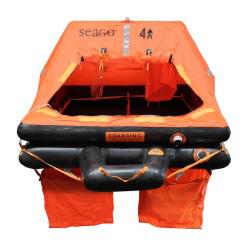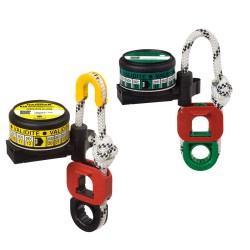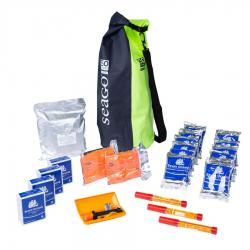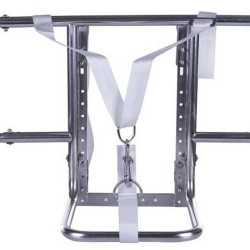A liferaft is an important part of the lifesaving equipment inventory onboard any yacht venturing to sea.
Liferafts are classed as the safe escape route of last resort.
If your yacht or boat is sinking in an emergency at sea, you should have your liferaft and safety grab bag with all your personal safety essentials ready to deploy at a moment's notice.
The chances of survival in the sea rather than in a liferaft are significantly reduced in benign conditions and very slim indeed in cold and rough seas.
Liferafts are notoriously difficult to get into from the sea, so bear this in mind when preparing to abandon ship.
"One should only ever step up into a liferaft" is an old adage but has proven to be worth bearing in mind.
RYA safety courses are available where training is given in deploying and boarding a liferaft, allowing first-hand experience in controlled conditions (wave machine-activated swimming pool)
Liferaft Capacity: Liferafts are rated by the number of persons they can accommodate safely, e.g. 4 man, 6 man, 8 man. The liferaft capacity should be selected by the number of potential crew members but is not mandatory or even necessarily advisable for all berths. Liferafts are stowed in either a hard canister or a soft valise. Sailing offshore without a liferaft would be foolhardy on a small yacht, but it is worth remembering that it is mandatory for any pleasure craft with an overall length of 13.7 metres or over. It is also mandatory for chartering, offshore racing and organised rallying.
The Maritime and Coastguard Agency publish regulations and guidelines for lifesaving and fire-fighting equipment on yachts. MCA Regulations It's well worth consulting even if your yacht is less than 13.7 metres.
Liferaft standards: The regulations have been difficult to assess for many years because several different organisations have suggested different minimum specifications. The ISO 9650-1 standard is now recognised as the all-important benchmark for leisure liferafts and covers (will supersede) all ISAF and RORC requirements. The ISO 9650-2 standard is a reassuringly high benchmark for leisure liferaft design and manufacture but will not suffice for Offshore or Ocean organised events, e.g. RORC racing or ARC Cruising.
Liferaft provisions/equipment are also classed according to the anticipated time factor between deployment and rescue, e.g. Ocean <24 hours - Ocean >24 hours. The quality standards for commercial liferafts are governed by SOLAS (Safety of Life at Sea) Wheeelmark or MCA approval.
The Jimmy Green Liferaft Selection Guide offers further insight into the latest specifications and regulations.
Selecting a liferaft: Rather like purchasing your lifejacket, but much more expensive - choose from a range suited to your anticipated cruising waters and buy the best you can afford. Remember that once you have abandoned ship, the length of your yacht will be of no consequence to your survival. A large factor in living to tell the tale will be the quality of the liferaft and the contents. The design, construction and manufacturing material,s along with the quantity and quality of the provisions/facilities that are included, should be a major consideration in your purchase. In addition, it is important to gather a safety grab bag of essentials to supplement what is already in the liferaft, e.g. locator beacons, additional fresh water and, in anticipating a positive outcome, your most important personal possessions, e.g. passport, credit cards.
Liferaft features to look out for: A thermo-insulated inflatable floor for protection against extreme temperatures. Adequate provision of practicable ballast pockets to greatly reduce the risk of capsizing. A sensible drogue or sea anchor for improved stability, supplied with sufficient tangle-free rope stowed in a manner ready for quick deployment. An automatically erected canopy will prevent total inversion, aid righting in the event of capsizing, and provide protection from the elements. Boarding facility - a ramp, inflatable step, ladder or a combination of these three boarding aids are essential for getting into a liferaft from the sea. Liferaft Servicing Requirements - important aspects are listed below. All these features are available in Seago Liferafts
Liferaft Stowage: Your liferaft should be stowed so that it is easily deployable in an emergency and preferably so that it can be reached after an inversion. Remember to secure the painter to the yacht - the painter activates the inflation device when launching the liferaft and secures it to the yacht temporarily while you disembark. Liferaft canisters are robust, can be stored on deck and may be fitted with a hydrostatic release which will automatically deploy the liferaft if it is submerged, e.g. during a rapid sinking. Liferafts are also available in a valise which is basically a storage bag. A valise is more convenient if storage in a locker or down below is the only sensible option, but it still needs to be easy to deploy in an emergency.
Liferaft Servicing: Once you have selected and purchased your liferaft, you must adhere to the manufacturer's recommendations on liferaft servicing. Liferaft manufacturers should clearly state the required servicing intervals. Select an internationally recognised manufacturer so that a reputable Liferaft Service Station can carry out your service without any problem. Consider the servicing frequency, costs, and convenience (location) and whether the manufacturer has a network for servicing, which will set your mind at rest regarding your next voyage. Witnessing the service and repacking the liferaft will give you peace of mind.
Grab Bag Contents: Check what is already supplied by the manufacturer in the liferaft and add any portable items that will improve your comfort, survival and, ultimately, rescue.
For a more comprehensive list, go to Grab Bag Contents
Main Menu
Main Menu
Back
Main Menu
Back
Main Menu
Back
Back
Main Menu
Back
Main Menu
Back
Back
Main Menu
Back
Main Menu
Main Menu
Back
Main Menu
Back
Back
Back
Back
Back
Back
Back
Back




















